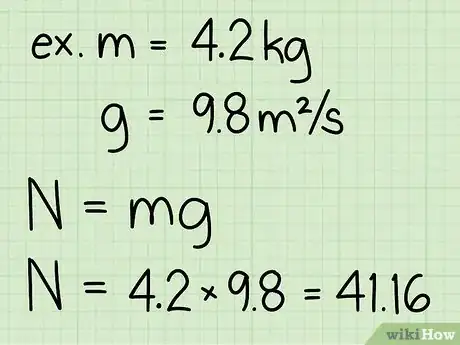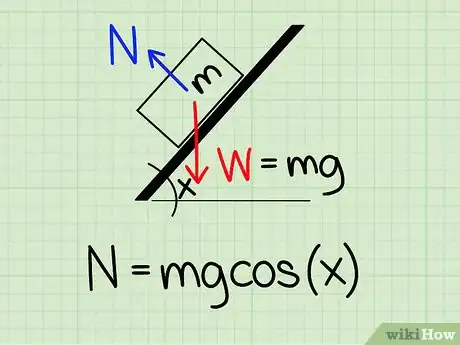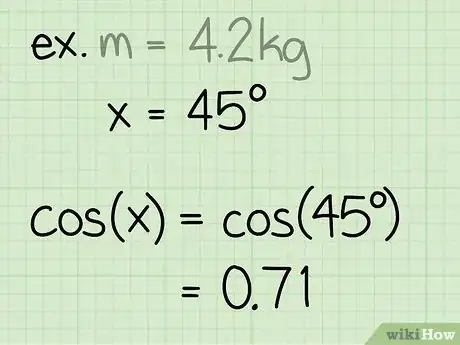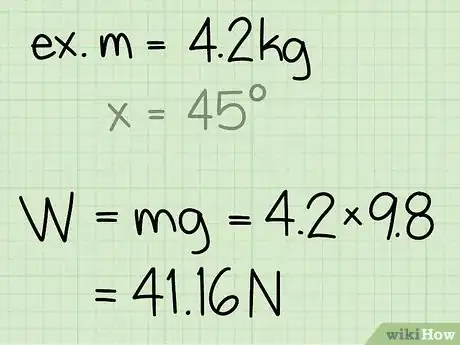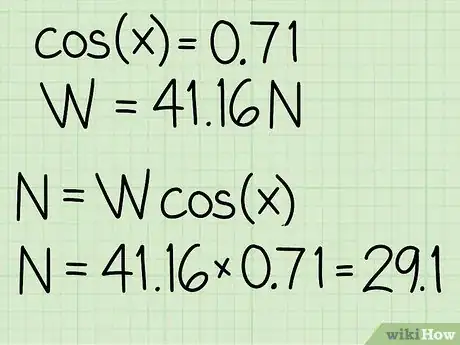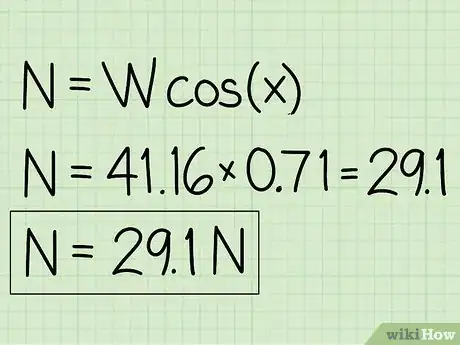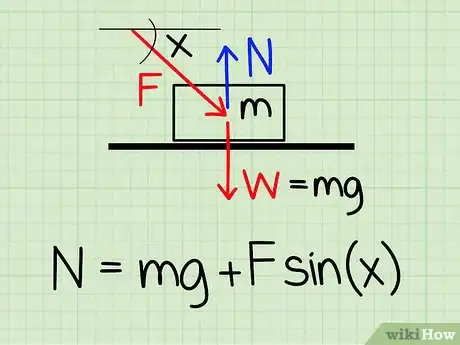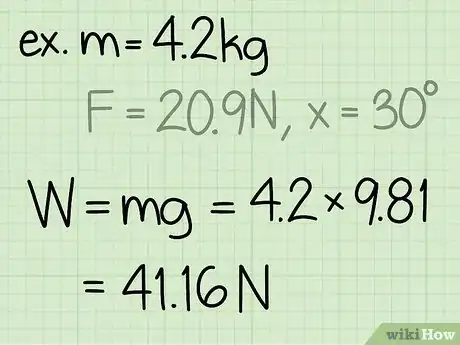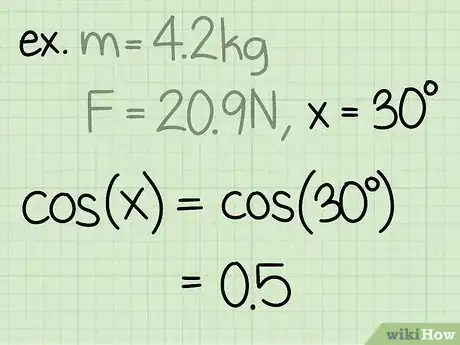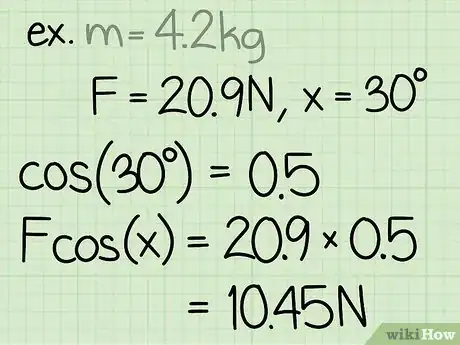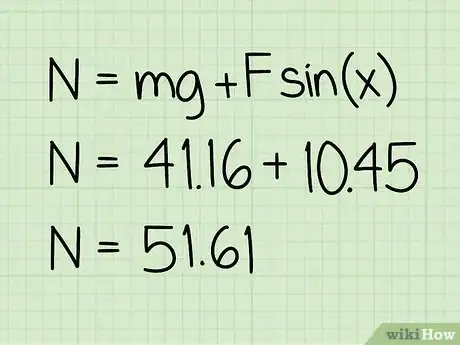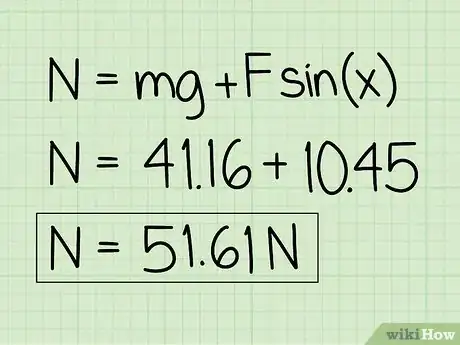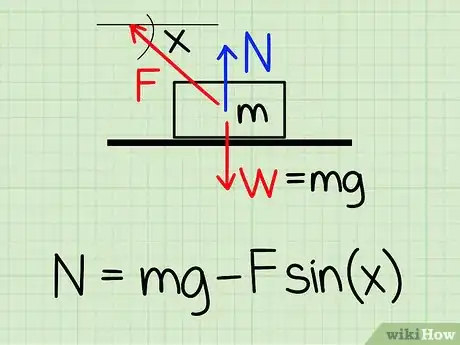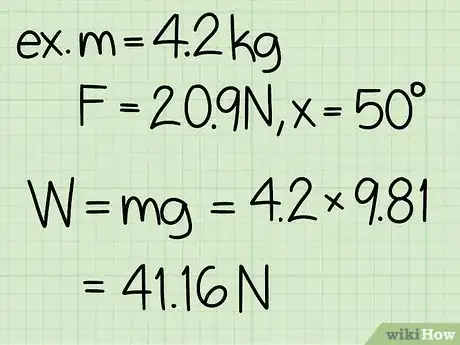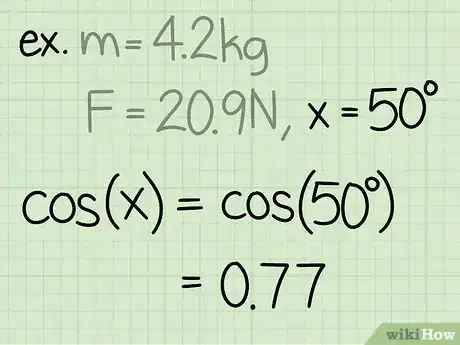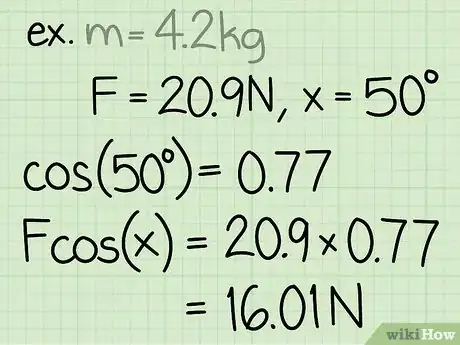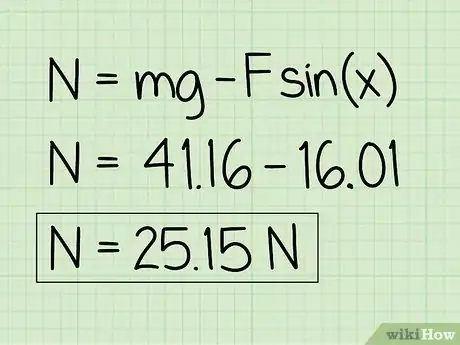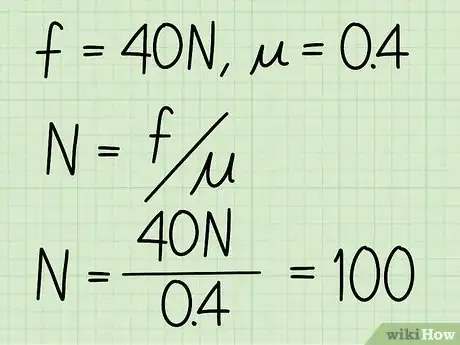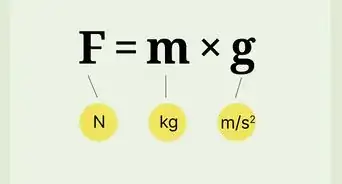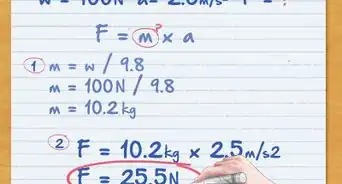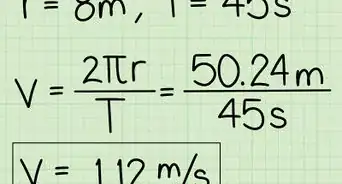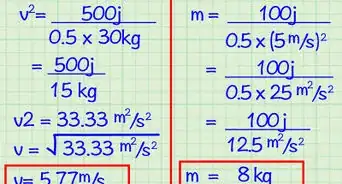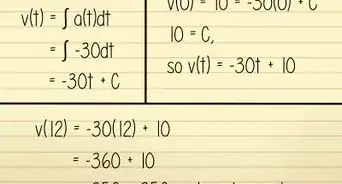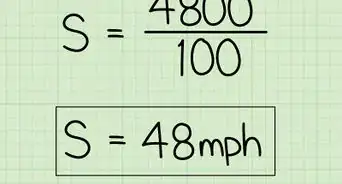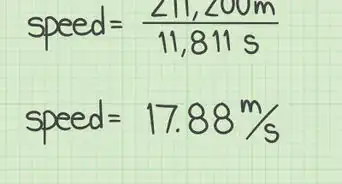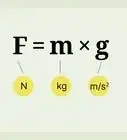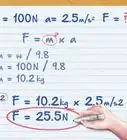wikiHow is a “wiki,” similar to Wikipedia, which means that many of our articles are co-written by multiple authors. To create this article, 16 people, some anonymous, worked to edit and improve it over time.
There are 11 references cited in this article, which can be found at the bottom of the page.
This article has been viewed 821,629 times.
Learn more...
Normal force is the amount of force required to counteract the other forces in any given scenario. The best way to go about finding it depends on the circumstances of the object and the variables you have data for. Keep reading to learn more.
Steps
Normal Force at Rest
-
1Understand what normal force refers to. Normal force refers to the amount of force use to counteract the force of gravity.[1]
- Imagine a block sitting on a table. The force of gravity pulls the block toward the Earth, but clearly, there is some force at work preventing the block from crashing through the table and finishing its descent toward the ground. The force responsible for stopping the block in spite of gravitational force is the normal force.
-
2Know the equation for normal force of an object at rest. When calculating an object's normal force when that object is at rest on a flat surface, use the formula: N = m * g[2]
- In this equation, N refers to the normal force, m refers to the object's mass, and g refers to the acceleration of gravity.
- For an object sitting on a flat surface, with no outside forces at work, the normal force is equal to the object's weight. In order to keep the object still, the normal force must be equal to the force of gravity at work on the object. The force of gravity at work on the object is that object's weight, or its mass multiplied by the acceleration of gravity.
- Example: Find the normal force of a block with a mass of 4.2 kg.
Advertisement -
3Multiply the object's mass and the acceleration of gravity. Doing so will give you the weight of the object, which ultimately equals the normal force of the object as it sits at rest.[3]
- Note that the gravitational acceleration at the Earth's surface is a constant: g = 9.8 m/s2
- Example: weight = m * g = 4.2 * 9.8 = 41.16
-
4Write down your answer. The previous step should complete the problem, giving you your answer.
- Example: The normal force is 41.16 N.
Normal Force on an Incline
-
1Use the right equation. To calculate the normal force of an object at an angle, you need to use the formula: N = m * g * cos(x)[4]
- For this equation, N refers to the normal force, m refers to the object's mass, g refers to the acceleration of gravity, and x refers to the angle of incline.
- Example: Find the normal force of a block with a mass of 4.2 kg, sitting on a ramp with an incline of 45 degrees.
-
2Find the cosine of the angle. The cosign of an angle equals the sine of the complementary angle, or the adjacent side divided by the hypotenuse of the triangle formed by the incline.[5]
- This value is often determined by a calculator, since the cosine of any angle is constant to that angle, but you can compute it manually, as well.
- Example: cos (45) = 0.71
-
3Find the object's weight. The weight of an object equals the mass of the object multiplied by the acceleration of gravity.[6]
- Note that the gravitational acceleration at the Earth's surface is a constant: g = 9.8 m/s2
- Example: weight = m * g = 4.2 * 9.8 = 41.16
-
4Multiply the two values together. In order to find the normal force, you need to multiply the weight of the object by the cosine of the angle of incline.[7]
- Example: N = m * g * cos(x) = 41.16 * 0.71 = 29.1
-
5Write your answer. The previous step should complete the problem and give you your answer.
- Note that for an object sitting on an incline, the normal force should be less than the weight of the object.
- Example: The normal force is 29.1 N.
Normal Force with an External Downward Force
-
1Use the right equation. To calculate the normal force of an object at rest when an outside force acts downward on that object, use the equation: N = m * g + F * sin(x)'[8]
- N refers to the normal force, m refers to the object's mass, g refers to the acceleration of gravity, F refers to the outside force, and x refers to the angle between the object and the direction of the outside force.
- Example: Find the normal force of a block with a mass of 4.2 kg, when a person is pressing down on the block at a 30 degree angle with a force of 20.9 N.
-
2Find the object's weight. The weight of an object equals the mass of the object multiplied by the acceleration of gravity.[9]
- Note that the gravitational acceleration at the Earth's surface is a constant: g = 9.8 m/s2
- Example: weight = m * g = 4.2 * 9.8 = 41.16
-
3Find the sine of the angle. The sine of an angle is calculated by dividing the side of the triangle opposite the angle by the hypotenuse of the angle.
- Example: sin(30) = 0.5
-
4Multiply the sine by the outside force. The outside force, in this instance, refers to the force acting downward on the object.
- Example: 0.5 * 20.9 = 10.45
-
5Add this value to the weight. Doing so will give you the normal force at work.
- Example: 10.45 + 41.16 = 51.61
-
6Write your answer. Note that for an object at rest being influenced by an external, downward force, the normal force will be greater than the weight of the object.
- Example: The normal force is 51.61 N.
Normal Force with an External Upward Force
-
1Use the right equation. To calculate the normal force of an object at rest when an outside force acts upward on that object, use the equation: N = m * g - F * sin(x)'[10]
- N refers to the normal force, m refers to the object's mass, g refers to the acceleration of gravity, F refers to the outside force, and x refers to the angle between the object and the direction of the outside force.
- Example: Find the normal force of a block with a mass of 4.2 kg, when a person is pulling up at the block at a 50 degree angle with a force of 20.9 N.
-
2Find the object's weight. The weight of an object equals the mass of the object multiplied by the acceleration of gravity.
- Note that the gravitational acceleration at the Earth's surface is a constant: g = 9.8 m/s2
- Example: weight = m * g = 4.2 * 9.8 = 41.16
-
3Find the sine of the angle. The sine of an angle is calculated by dividing the side of the triangle opposite the angle by the hypotenuse of the angle.
- Example: sin(50) = 0.77
-
4Multiply the sine by the outside force. The outside force refers to the force acting upward on the object, in this instance.
- Example: 0.77 * 20.9 = 16.01
-
5Subtract this value from the weight. Doing so will give you the normal force at work.
- Example: 41.16 – 16.01 = 25.15
-
6Write your answer. Note that for an object at rest being influenced by an external, upward force, the normal force will be less then the weight of the object.
- Example: The normal force is 25.15 N.
Normal Force and Friction
-
1Know the basic equation for kinetic friction. Kinetic friction, or the friction of an object in motion, is equal to the coefficient of friction multiplied by the normal force of an object. In equation format, that looks like: f = μ * N[11]
- In this equation, f stands for friction, μ refers to the coefficient of friction, and N refers to the normal force of the object.
- A "coefficient of friction" is the ratio between frictional resistance to normal force, which is responsible for pressing the two opposing surfaces together.
-
2Rearrange the equation to isolate the normal force. If you have a value for the kinetic friction of an object, as well as that object's coefficient of friction, you can calculate the normal force by using the formula: N = f / μ[12]
- Both sides of the original equation were divided by μ, thereby isolating normal force on one side while accounting for the coefficient of friction and kinetic friction on the opposite side.
- Example: Find the normal force of a block when the coefficient of friction is 0.4 and the amount of kinetic friction itself is 40 N.
-
3Divide the kinetic friction by the coefficient of friction. This is essentially all you need to do to find the value of the normal force.
- Example: N = f / μ = 40 / 0.4 = 100
-
4Record your answer. If desired, you can check your answer by plugging it back into the original equation for kinetic friction. Otherwise, you have completed the problem.
- Example: The normal force is 100.0 N.
Community Q&A
-
QuestionWhy does N=(m*g)-[F*sin(x)] when Normal Force is with an External Upward Force?
 Community AnswerYou subtract the y-component of the external force (-[F*sin(x)]) because the force is upward, lifting some the mass off of the surface that it is on, therefore, the normal force would be less. Think about it as you holding a 5 gallon bucket of water above your head, and a friend (an external upward force) pulls up on the bucket reducing the amount of mass that you have to lift. The amount that you have to lift would be the total mass of the bucket times gravity, minus the amount that your friend lifted.
Community AnswerYou subtract the y-component of the external force (-[F*sin(x)]) because the force is upward, lifting some the mass off of the surface that it is on, therefore, the normal force would be less. Think about it as you holding a 5 gallon bucket of water above your head, and a friend (an external upward force) pulls up on the bucket reducing the amount of mass that you have to lift. The amount that you have to lift would be the total mass of the bucket times gravity, minus the amount that your friend lifted. -
QuestionFor an object sitting on an incline, why is the normal force less than the weight of the object?
 Community AnswerBecause weight of the object is the complete weight that is mass into acceleration due to gravity, whereas when an object is on an incline the normal acting on it is the component of the mg instead of the complete mg.
Community AnswerBecause weight of the object is the complete weight that is mass into acceleration due to gravity, whereas when an object is on an incline the normal acting on it is the component of the mg instead of the complete mg. -
QuestionHow do I find the normal force without mass?
 Community AnswerIf friction is the co-efficient of friction and frictional force is known, then N = F/ MU.
Community AnswerIf friction is the co-efficient of friction and frictional force is known, then N = F/ MU.
Things You'll Need
- Pencil
- Paper
- Calculator
References
- ↑ https://www.physicsclassroom.com/class/newtlaws/Lesson-2/Types-of-Forces
- ↑ https://www.varsitytutors.com/ap_physics_1-help/normal-force-and-weight
- ↑ https://www.varsitytutors.com/ap_physics_1-help/normal-force-and-weight
- ↑ https://www.physicsclassroom.com/class/vectors/Lesson-3/Inclined-Planes
- ↑ http://www.mathsisfun.com/sine-cosine-tangent.html
- ↑ https://www.omnicalculator.com/physics/normal-force
- ↑ https://emedia.rmit.edu.au/learninglab/sites/default/files/Forces_Slopes.pdf
- ↑ https://www.easycalculation.com/physics/classical-physics/normal-force-external-downward-force-calculator.php
- ↑ https://www.khanacademy.org/science/physics/forces-newtons-laws/normal-contact-force/v/normal-force-and-contact-force
- ↑ https://www.easycalculation.com/physics/classical-physics/normal-force-external-upward-force-calculator.php
- ↑ https://openstax.org/books/university-physics-volume-1/pages/6-2-friction
- ↑ https://phys.libretexts.org/Bookshelves/University_Physics/Book%3A_University_Physics_(OpenStax)/Book%3A_University_Physics_I_-_Mechanics_Sound_Oscillations_and_Waves_(OpenStax)/06%3A_Applications_of_Newton's_Laws/6.05%3A_Friction_(Part_2)
About This Article
To find normal force on an incline, use the equation N = mg cos(x), “m” being the object’s mass, “g” being the acceleration of gravity, and “x” being the angle of incline. Then, use a calculator to find the cosine of the angle, and write down that value. Next, determine the weight by multiplying the mass of the object by the acceleration of gravity, and write it down. Finally, multiply the value of the weight by the value of the cosine to determine the normal force. For more ways to find normal force, like how to find normal force at rest, read on!


